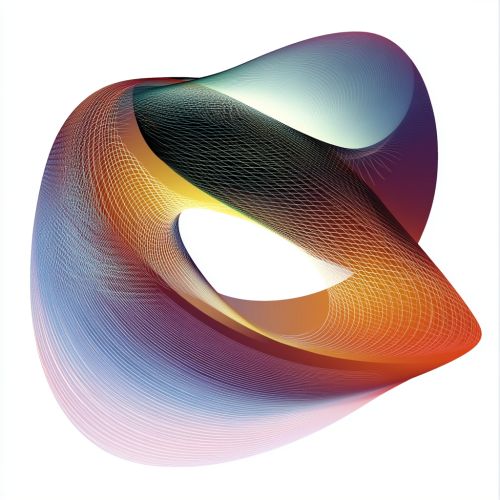Contact Geometry: Difference between revisions
(Created page with "== Introduction == Contact geometry is a branch of differential geometry that studies certain types of geometric structures on smooth manifolds. It is closely related to symplectic geometry, but while symplectic geometry deals with even-dimensional manifolds, contact geometry is concerned with odd-dimensional manifolds. The primary object of study in contact geometry is a contact structure, which can be thought of as a maximally non-integrable hyperplane distribution. =...") |
No edit summary |
||
| Line 43: | Line 43: | ||
* McDuff, D., Salamon, D. (1998). "Introduction to Symplectic Topology". Oxford University Press. | * McDuff, D., Salamon, D. (1998). "Introduction to Symplectic Topology". Oxford University Press. | ||
[[Image:Detail-97757.jpg|thumb|center|A smooth manifold with a contact structure, illustrating the hyperplane distribution in the tangent bundle.]] | |||
[[Category:Differential Geometry]] | [[Category:Differential Geometry]] | ||
[[Category:Mathematical Structures]] | [[Category:Mathematical Structures]] | ||
[[Category:Topology]] | [[Category:Topology]] | ||
Revision as of 12:48, 30 August 2024
Introduction
Contact geometry is a branch of differential geometry that studies certain types of geometric structures on smooth manifolds. It is closely related to symplectic geometry, but while symplectic geometry deals with even-dimensional manifolds, contact geometry is concerned with odd-dimensional manifolds. The primary object of study in contact geometry is a contact structure, which can be thought of as a maximally non-integrable hyperplane distribution.
Contact Structures
A contact structure on a smooth manifold \( M \) of dimension \( 2n+1 \) is a smooth hyperplane distribution \( \xi \) in the tangent bundle \( TM \) that is maximally non-integrable. This means that locally, \( \xi \) can be defined as the kernel of a 1-form \( \alpha \) such that \( \alpha \wedge (d\alpha)^n \) is nowhere zero. The pair \( (M, \xi) \) is called a contact manifold.
Examples of Contact Structures
One of the simplest examples of a contact structure is on \( \mathbb{R}^{2n+1} \) with coordinates \( (x_1, y_1, \ldots, x_n, y_n, z) \). The 1-form \( \alpha = dz - \sum_{i=1}^n y_i dx_i \) defines a contact structure because \( \alpha \wedge (d\alpha)^n \) is a volume form on \( \mathbb{R}^{2n+1} \).
Another important example is the standard contact structure on the unit sphere \( S^{2n+1} \subset \mathbb{C}^{n+1} \). The contact form is given by the restriction of the 1-form \( \alpha = \frac{i}{2} \sum_{j=1}^{n+1} (z_j d\bar{z}_j - \bar{z}_j dz_j) \) to the sphere.
Contact Transformations
A contact transformation (or contactomorphism) is a diffeomorphism of a contact manifold that preserves the contact structure. More precisely, a diffeomorphism \( \phi: M \to M \) is a contactomorphism if \( \phi_* \xi = \xi \). In terms of the defining 1-form \( \alpha \), this means that \( \phi^* \alpha = f \alpha \) for some nowhere-vanishing function \( f \).
Contact Vector Fields
A vector field \( X \) on a contact manifold \( (M, \xi) \) is called a contact vector field if its flow consists of contact transformations. This is equivalent to the condition that \( \mathcal{L}_X \alpha = g \alpha \) for some function \( g \), where \( \mathcal{L}_X \) denotes the Lie derivative with respect to \( X \).
Reeb Vector Field
Given a contact form \( \alpha \) on a contact manifold \( M \), the Reeb vector field \( R_\alpha \) is the unique vector field satisfying \( \alpha(R_\alpha) = 1 \) and \( d\alpha(R_\alpha, \cdot) = 0 \). The Reeb vector field plays a central role in the study of contact geometry, particularly in the context of contact homology and Reeb dynamics.
Legendrian and Transverse Submanifolds
A submanifold \( L \subset M \) of a contact manifold \( (M, \xi) \) is called Legendrian if it is everywhere tangent to the contact structure, i.e., \( T_p L \subset \xi_p \) for all \( p \in L \). Legendrian submanifolds are the contact analogs of Lagrangian submanifolds in symplectic geometry.
A submanifold \( T \subset M \) is called transverse if it is everywhere transverse to the contact structure, i.e., \( T_p M = T_p T \oplus \xi_p \) for all \( p \in T \).
Contact Homology
Contact homology is an invariant of contact manifolds that arises from counting certain types of pseudoholomorphic curves in the symplectization of the contact manifold. It is a part of the broader framework of symplectic field theory (SFT). The study of contact homology involves sophisticated techniques from Floer homology and Gromov-Witten theory.
Applications of Contact Geometry
Contact geometry has applications in various areas of mathematics and physics. In particular, it plays a significant role in the study of Hamiltonian dynamics, where contact structures naturally arise in the context of phase space reduction. Contact geometry is also relevant in the study of thermodynamics, where the contact structure can be used to describe the state space of a thermodynamic system.
See Also
- Symplectic Geometry
- Reeb Dynamics
- Floer Homology
- Gromov-Witten Theory
- Hamiltonian Dynamics
- Thermodynamics
References
- Arnold, V. I., Givental, A. B. (1990). "Symplectic Geometry". In: Dynamical Systems IV. Springer.
- Geiges, H. (2008). "An Introduction to Contact Topology". Cambridge University Press.
- McDuff, D., Salamon, D. (1998). "Introduction to Symplectic Topology". Oxford University Press.

